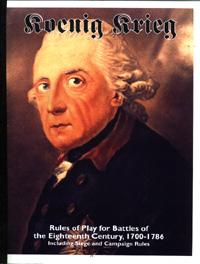

| Brian Weathersby ([email protected]) | ||||||||||
|---|---|---|---|---|---|---|---|---|---|---|
| I have KK, and over all I like the system. My complaint is
with the current edition of the rules put out by
Outland Games. The proofreading
on my set is horrible! Misspellings abound, charts are incorrect (look
at the 500-pt army on pg. 5) and the explanatory diagram on pg. 16 does not
have any labels attached to the units, although the text refers to the units
by label. While these may seem like petty complaints, if your presentation
is not good then your concepts/ideas will not get the consideration they
deserve, now matter how good they are.
Having said all that, I do like the game, as I mentioned earlier. The deployment phase is much better than the usual let's set up and then start moving wargame. Now you have to think about deployment, and use your light troops (clearly I play Austrians) as they are intended. Since it is a grand tactical game, I don't miss the detail within each battalion, a la Johnny Reb or Empire. Overall, I think the system is good and does what it was designed to do. I just wish the new owners would clean it up! | ||||||||||
| Dr. Brendan Moyle ([email protected]) | ||||||||||
| I'd like to respond to a few of John Kelly's comments. What always has to be borne in mind is that KK is a grand-tactical game. Low-level accuracy, such as would be relevant for a battalion or squadron commander, is kept at a minimum. Clearly there are 'false' rules at the battalion level, but this misses the mark. If a rule doesn't contribute to a brigade-level simulation, then its inclusion will simply be friction.
| ||||||||||
| John P Kelly ([email protected]) | ||||||||||
These grand tactical rules are a fast playing set that are great, if you don't
want to sweat the details and like rolling a handful of die hoping for a bunch
of 6's. They have a number of short comings and will not be terribly
satisfying to the scrupulous gamer interested in a historical simulation.
In short, these rules require a large dose of beer and pretzels for proper enjoyment. | ||||||||||
| Mark Cuomo ([email protected]) | ||||||||||
| A fast-playing set of Seven Years War rules, giving the players a good feel for warfare of the period. The system translates well to earlier periods, also. Well worth the price. A easy set of rules to teach to novice gamers, with enough tactical 'meat' to keep the grognards at the table... | ||||||||||
| Jim Davis ([email protected]) | ||||||||||
| I have been playing KK since it was published. The first time I read the rules, I decided they were strange and useless. I was eventually enticed by a free set and leared to love them. I found they gave a great Seven Years War battle, and were easy to learn and teach. Most players pick up the basic rules in two or three turns, but the use of brigades, when to move first, why a better commander helps all take time to appriciate. The set-up and pre-battle manuever and scouting add a lot to the flavor. The two-deep mounting looks good, and the national armies seem to follow what I've read about them. Good set of rules. | ||||||||||
| Sven Lugar ([email protected]) | ||||||||||
| I have played Koenig Krieg since 1982 or 1983, and have had some legendary battles using the system. I've used both first and second edition rules. I find it the perfect system to introduce wargaming to new players because of its straight-forward, fast, and easy-to-learn design. It captures the flavor of the armies and the tactics of the period, without delving into overly complex rules that make many games unplayable for the beginner. It provides a realistic balance between the three major arms of an army. It is simple and realistic enough to afford the veteran player with enjoyment and a fast game. I've known many players to incorporate various concepts and rules from the game into their own house-rules for a broad variety of periods. It has a wonderful set-up system, and hidden movement rules that put the fog back into the opening of a battle. I can't think of a basic wargame that I would rather recommend. |
If you would like to add your opinion to this webpage, use the following form or send email to the editor.
| Last Updates | |
|---|---|
| 2 November 1999 | comments by Brian Weathersby |
| 13 August 1999 | expanded artillery comments by Dr. Brendan Moyle |
| 7 August 1999 | comments by Dr. Brendan Moyle |
| 6 July 1999 | comments by John P Kelly |
| 21 April 1999 | comments by Mark Cuomo |
| Comments or corrections? | |